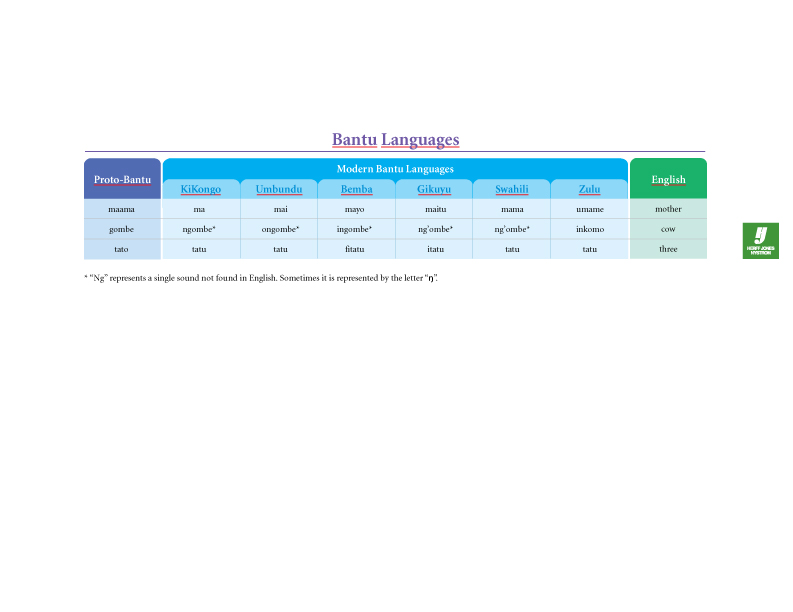
There are between 300 and 550 Bantu languages today, with disagreement over what is a separate language and what is a dialect of the same language.
All Bantu languages have a common vocabulary and shared grammatical traits. They use different tones, or pitches, to change the meaning of words. All words use prefixes and suffixes that vary depending on how the word is used, its class, and its number (singular or plural). For example the word "Bantu" comes from the Proto-Bantu word "ntu" (person) with the prefix "ba" meaning the word is plural. As a result, the greatest similarities among Bantu words are the roots after the prefix (the first syllable).
All Bantu languages have a common vocabulary and shared grammatical traits. They use different tones, or pitches, to change the meaning of words. All words use prefixes and suffixes that vary depending on how the word is used, its class, and its number (singular or plural). For example the word "Bantu" comes from the Proto-Bantu word "ntu" (person) with the prefix "ba" meaning the word is plural. As a result, the greatest similarities among Bantu words are the roots after the prefix (the first syllable).
Experts disagree about how different languages and dialects are related to each other. There are no written records in any Bantu languages earlier than the 1500s. The records available are from European, mainly Portuguese, sources. Generally languages do not change enough in 500 years to split into daughter languages. (Compare Shakespearean English to modern English.)
All modern Bantu languages used modified Roman alphabets, introduced between 1550 and 1900, though some also use an Arabic-based alphabet.
All modern Bantu languages used modified Roman alphabets, introduced between 1550 and 1900, though some also use an Arabic-based alphabet.
Proto-Bantu is a re-creation of the language spoken about 500 B.C. in modern Cameroon, based on similarities in modern Bantu languages. Proto-Bantu is part of the Niger-Congo family, which is spoken throughout most of sub-Saharan Africa. The Niger-Congo family has around 1,400 different languages spoken by 600 million people.
KiKongo is spoken by about 1.5 million people in the Democratic Republic of Congo and Angola, with about 7 million using it as a second language.
KiKongo is one of the first Bantu languages studied by Europeans, with written studies dating back to 1591. This also gives us one of the oldest written records of any Bantu language.
KiKongo is one of the first Bantu languages studied by Europeans, with written studies dating back to 1591. This also gives us one of the oldest written records of any Bantu language.
Umbundu is spoken by about 4 million people in southern Angola.
Bemba is spoken by about 3.6 million people, mainly in northern Zambia and southeastern Democratic Republic of Congo.
Gikuyu, sometimes called Kikuyu, is spoken by about 7.2 million people in Kenya. Gikuyu uses a Roman-based alphabet.
Swahili developed as a trade language, allowing different groups, originally Arabs and East Africans, to have a common language. As a result, Swahili has many Arabic words including the word Swahili itself, which means "of the coast". Today Swahili continues to be used mainly as a common second language among different groups.
Swahili is spoken by about 35 million people along the Indian Ocean coast of Africa from Kenya to Mozambique, as well as in Burundi, Rwanda, Uganda, and Democratic Republic of Congo. There are also Swahili-speaking communities in Oman and Somalia. It is the only indigenous African language commonly used by the African Union. Swahili was originally written with an Arabic-based alphabet but uses a Roman-based alphabet today.
Swahili is spoken by about 35 million people along the Indian Ocean coast of Africa from Kenya to Mozambique, as well as in Burundi, Rwanda, Uganda, and Democratic Republic of Congo. There are also Swahili-speaking communities in Oman and Somalia. It is the only indigenous African language commonly used by the African Union. Swahili was originally written with an Arabic-based alphabet but uses a Roman-based alphabet today.
Zulu includes tongue clicks as constants, adopted from the neighboring Khoisan languages. Tongue clicks are one of the rarest sounds used in human speech.
Zulu is spoken by about 10.3 million people in South Africa and Lesotho.
Zulu is spoken by about 10.3 million people in South Africa and Lesotho.
English is not a Bantu language. It is an Indo-European language. There are English words derived from Bantu languages including gumbo, jumbo, Kwanzaa, mambo, and safari.